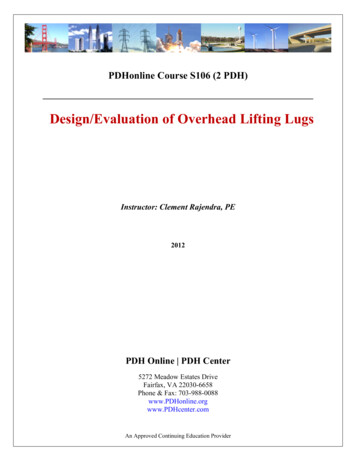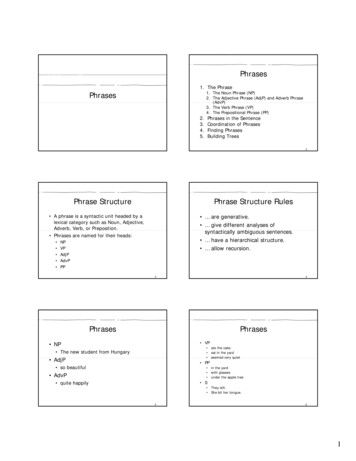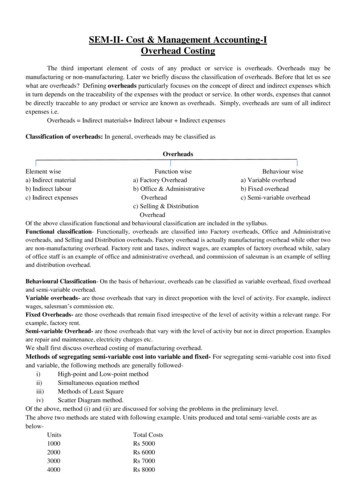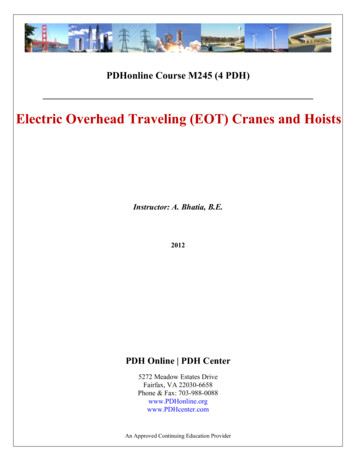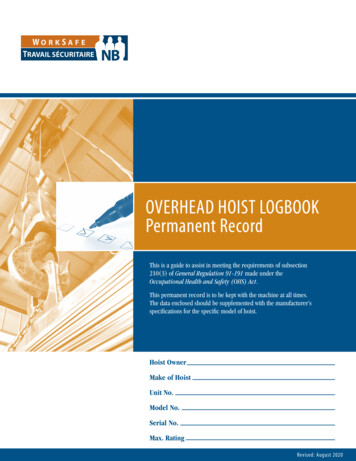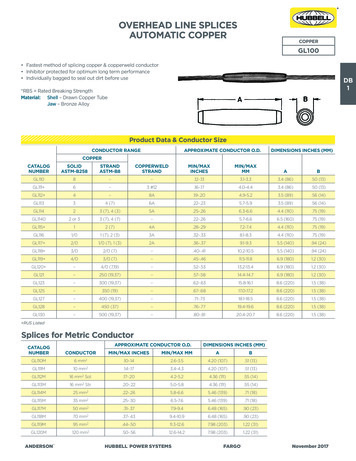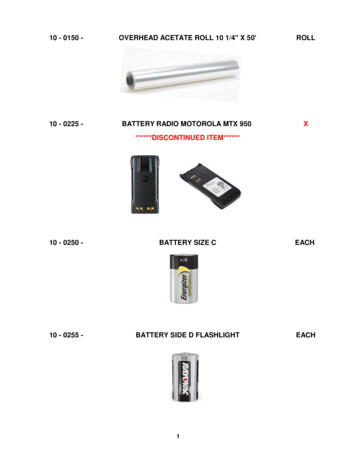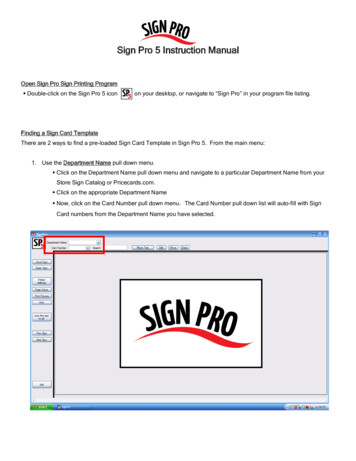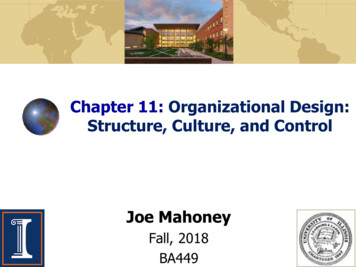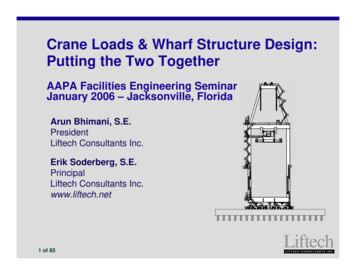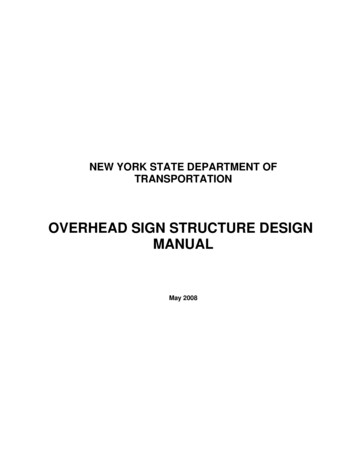
Transcription
NEW YORK STATE DEPARTMENT OFTRANSPORTATIONOVERHEAD SIGN STRUCTURE DESIGNMANUALMay 2008
NEW YORK STATE DEPARTMENT OF TRANSPORTATION (NYSDOT)OVERHEAD SIGN STRUCTURE DESIGN MANUALTABLE OF CONTENTS1234INTRODUCTION . 11.1Scope . 11.2Background . 11.3General Guidance in Selecting OSS . 21.4Applicable Specifications. 31.5Definitions. 4METHOD 1 - STANDARD OSS SELECTION USING BD SHEETS . 52.1Sign Selection and Layout. 52.2Electronic BD Sheets. 52.3Sign Structure Identification Number. 52.4Maximum Post Height . 52.5OSS Span or Arm Length . 62.6Limitations of the Standard OSS Selection Procedure. 62.7Structure Type Selection . 72.8Foundation Selection. 82.9Cantilever Trussed Arm Spacing Selection . 102.10Additional Information Required on BD-OS1/BD-OS8 . 112.11Additional OSS . 112.12Assembly of Appropriate BD Sheets for the PS&E . 112.13Contractor/Fabricator Options . 11METHOD 2 - SPECIAL DESIGN - INDEPENDENT ANALYSIS. 133.1Special Design Applications . 133.2Overview. 133.3Special Design Procedure . 14REFERENCES . 16APPENDIX AAPPENDIX BAPPENDIX CAPPENDIX DAPPENDIX EMay 2008Major Changes from the 1968 Design Manual and the 2000 Interim SteelDesign (EI 00-035)Design Assumptions Used for Standard OSS on BD-OS1 Through BD-OS14Issues And Options Evaluated During the Development of the Standard OSSDesignsFoundation Loads at Standard OSSExample Special Median Support Foundations for Overhead Sign Structuresin Concrete Barrieri
OVERHEAD SIGN STRUCTURE DESIGN MANUAL1INTRODUCTION1.1ScopeThis manual describes the procedures to be used to design and detail cantilever and spanoverhead sign structures (OSS) in the State of New York. These procedures shall be used forthe design of all OSS.Overhead signs include signs over any portion of the roadway, including the shoulders,requiring vertical clearance for vehicles to pass underneath. Overhead signs are used toprovide the traveling public with clear messages under a variety of conditions, directly over theroadway. The National Manual on Uniform Traffic Control Devices for Streets and Highways (National MUTCD) and the New York State Supplement, contains the requirements fordetermining when and where overhead signs should be used.Typically, overhead signs are supported by OSS. For purposes of this manual, OSS are definedas span or cantilever structures supported on posts, designed to carry signs over the roadway.Less frequently, overhead signs may be supported by cable structures, mounting to bridgefascias or piers, or other unique structural arrangements.This manual is limited in scope to typical OSS, consisting of post-supported span or cantileverstructures. Non-typical support structures shall be designed on a case by case basis using theparameters and references presented in this manual.Two separate design/selection methods are presented:Method 1 STANDARD OSS SELECTION USING BD SHEETS applies only to structuressupporting 1/8 inch (3 mm) thick aluminum sign panels. These standard designs are expectedto cover the great majority of OSS requirements in NYS.Method 2 SPECIAL DESIGN - INDEPENDENT ANALYSIS is used for OSS that fall outsidethe limits covered by the BD sheet standard selection tables, including those that support signpanels greater than 1/8 inch (3 mm) in thickness.The scope of this manual does not include design guidance for protection of OSS as fixedobjects, determining the location and type of signs to be supported by the structure, determiningwhether or not an OSS is needed in lieu of a ground mounted sign or traffic pole design. Suchguidance may be found in the Highway Design Manual (HDM) and the National MUTCD withNYS Supplement.1.2BackgroundThe Department designed and built OSS using the 1968 Manual in combination with standardSheets and Drawings almost exclusively until October 2000. The 1968 method used aluminumtri-chord trusses with steel posts for spans, and either steel or aluminum elements forcantilevers.May 20081
NYSDOT OSS Design ManualThe Department recognized that the AASHTO recommendations for forces and loads used inthe design of overhead sign structures had changed since 1968. New factors, including theissue of Heat Affected Zone for welded aluminum structures, fatigue loads and analyses,changes in height and exposure factors, new wind pressure formulas and changes in groupload combination factors were being investigated and incorporated into AASHTO criteria.In addition to the changes occurring in AASHTO criteria, statewide inspection programsrevealed that the most significant and common problem observed was cracked weldedaluminum connections. Further analyses, based on recent AASHTO criteria, have confirmedthat steel welds have 2 to 3 times the Constant Amplitude Fatigue Life (CAFL) as equivalentaluminum welds.As a result of the new AASHTO criteria and inspection results, the Department issued interimsteel designs for span structures in October 2000 (EI 00-035) and discontinued the use ofaluminum OSS.1.3General Guidance in Selecting OSSThe National MUTCD with NYS Supplement continues to be the authoritative source indetermining what signs are necessary and where they are to be located. Ground mounted signsmay be considered in lieu of overhead signs, if permitted by the MUTCD. In all instances, signsshould be placed in a manner that will minimize potential danger and confusion caused bymotorist uncertainty.When an overhead sign is needed, the proper means of support shall be selected. The followingis basic guidance for typical circumstances and is not intended to be comprehensive.1. When the signage is intended for the under roadway, use a nearby bridge fascia if thebridge is structurally adequate for the required loads and forces and the skew angle of theexisting bridge is not excessive (depending upon the width of the sign, a skew of up to about40 degrees may be accommodated by the structural mounting attachments). The bridgeshall be located within the limits specified by the MUTCD for the overhead sign. This optionusually has a substantially lower initial cost than an OSS and will minimize traffic disruptionduring future OSS inspections. (Note: Not all bridges are suitable for supporting overheadsigns and standard details do not exist for mounting attachments. The Regional StructuresEngineer [RSE] shall be consulted. A full analysis shall be performed to develop a suitableattachment design for the specific signage.) An analysis is required to determine if thebridge is structurally adequate to support the overhead signage. A load rating calculation,including the signage and its mounting attachment, shall be completed and included in theBridge Identification Number (BIN) folder.2May 2008
2. Avoid using an OSS to span both directions of a divided highway to support signs intendedfor only one direction. Instead, use a structure spanning one direction with a mediansupport, or use a cantilever, depending on the sign location. (Note: A median supportfoundation will involve a special design if it is located within a barrier. See Appendix E forexamples. In other cases it may require protection as a fixed object; see HDM Chapter 10.)An OSS spanning two traffic directions will generally be three to four times more costly thanan equivalent one direction structure due to its greater length and required section.Additionally, a structure spanning two traffic directions will be approximately twice as costlyto inspect and cause twice the traffic disruption and potential hazard compared to anequivalent one direction structure.3. Cantilever structures shall generally be used to support signs over the shoulder and/or thetravel lane nearest the post. Long arm cantilevers will generally be more costly thanequivalent spans and are subjected to much greater fatigue loads than span type structures.In addition, they are less redundant than the current dual post, span type OSS standarddesigns. On the other hand, cantilevers with shorter arms for signs over the shoulder ortravel lane nearest the post will generally be less costly to construct and inspect. In certaincases, two small cantilevers may be considered in lieu of an OSS spanning two directions,depending on site specific conditions.4. Avoid placing an OSS on a bridge when the signage is intended for the over roadway. Thistype of structure requires specially designed post supports and connections. In addition,bridge vibrations may affect the OSS. If there is no alternative to an OSS on a bridge, use aspan structure in lieu of a cantilever. Cantilever structures supported on bridges should beavoided due to the resulting load and force combinations. Note that the standard OSSwere not designed to accommodate fatigue occurring from bridge vibration. A dynamicanalysis will need to be performed on OSS located on bridge superstructures. Also, if a signstructure must be mounted on a bridge, the designer should explore the possibility of usinga concrete pier extension as a support in lieu of the bridge superstructure.5. Avoid using cantilever structures to support variable message signs (VMS) due to theeccentricity of the VMS dead load, the magnitude of fatigue forces and the potential for outof plane bending.1.4Applicable Specifications1.4.1 Design SpecificationsThe New York State Department of Transportation Standard Design Specifications forOverhead Sign Structures, latest version.1.4.2 Construction and Material SpecificationsThe Standard Specifications, Construction and Materials, New York State Department ofTransportation, Office of Engineering (latest version), with all additions and modificationscurrent at time of design.May 20083
NYSDOT OSS Design Manual1.5DefinitionsSign Height:The overall vertical dimension of the sign, including all supplementarypanels.Sign Area:The summation of the areas of all signs (actual or future) to be placed onthe structure.Nominal Post Height: The distance from the centerline of truss to the bottom of base plate.Quad-Truss:An assembly consisting of four chords, connected by bracing in fourplanes and internal bracing to distribute loads among the planes.Exposure Factor, Kz: A dimensionless coefficient that corrects the magnitude of windpressure referenced to a height above the ground of 32.8 ft (10 m) forthe variation of wind speed with height.4May 2008
2METHOD 1 - STANDARD OSS SELECTION USING BD SHEETSBD sheets in the OS series provide a simple procedure for designers to select the appropriateOSS for their project. These BD sheets also include all appropriate details required and shall beused as contract sheets in the plans, specifications and estimate (PS&E). The BD-OS sheets donot require modification when Method 1 is used. The designer need only enter requiredinformation on BD-OS1 (for span structures) and/or BD-OS8 (for cantilever structures).The standard selection tables contained in the BD sheets have been developed to satisfy thegreat majority of requirements for typical cantilever and span OSS supporting standard 1/8 inch(3 mm) thick aluminum sign panels, within specified limits as noted in Section 2.6. Whenrequirements for OSS exceed these limits, Method 2 for special design procedures shall beused, as described in Section 3. Special design procedures shall also be used for butterfly,multi-span or combination span and cantilever sign structures.The procedure for selecting an OSS and completing the BD sheets for incorporation into thecontract plans follows in Sections 2.1 through 2.12. Instructions for the EIC to record theconstructed foundation types are included in Section 2.13.2.1Sign Selection and LayoutDetermine the size, type and location of sign panels to be supported by the OSS. Evaluatewhether future sign panel size increases are likely. If changes are expected, the sign structureshall be designed to accommodate the larger of either the current or future sign area. Determinethe total sign area to be supported by the OSS by summing all sign panel areas.Based on the sign locations and sign areas, determine if a span or cantilever type OSS isneeded. Generally, cantilever structures should on
NYSDOT OSS Design Manual 2 May 2008 The Department recognized that the AASHTO recommendations for forces and loads used in the design of overhead sign structures had changed since 1968. New factors, including the issue of Heat Affected Zone for welded aluminum structures, fatigue loads and analyses,
